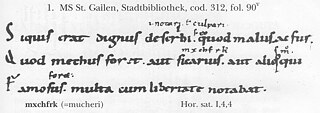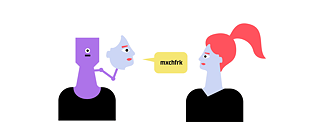Not everyone needs to know everything. And just to be on the safe side, secret languages are invented. They existed in ancient times and they still exist today. Klaus Siewert, a Germanist, linguist and cultural scientist, has been documenting and researching secret and special languages since the 1990s. As a new columnist, he tells us the story of secret language communication.
Ich geb´dir bees meis schiwwem schuck für die beheime! – Mei ratt, oder kein masematten! (“I’ll give you 230 marks for the cattle!” – “300 or the deal is off!”)Pardon me? 300 marks? I only wanted to buy milk – not the whole cow (beheime). The negotiations between a cattle trader and a potential buyer at a market somewhere in Germany are conducted undercover to prevent outsiders from gaining an insight into the internal price negotiations. The means to this end: Number words from Western Yiddish.
The need for linguistic isolation is as old as humanity – and the opposite of what language is supposed to do: enable mutual understanding and, at best, communication between people. In the next parts of “Word! The Language Column” I invite you to take a walk through the history of secret language communication.
It all began in Mesopotamia
The first evidence of the encoding of text is a clay tablet from Mesopotamia – a recipe written in cuneiform around 1,500 BC for making a glaze for clay vessels. Scribes of the Egyptian civilisation are said to have invented secret hieroglyphs as early as the 4th millennium BC. Prominent examples of secret language message transmission in Greek and Roman antiquity are the Skytale of Sparta (Greek: skytala “cylinder”) and the “Caesar code”. This was a transposition algorithm based on the alphabet in which letters were simply shifted by certain positions – the forerunner of the ENIGMA cipher machine used in the Second World War.It still took a couple of centuries before the German language came into play. A bit of history in fast forward: After the fall of the Roman Empire, the Germanic Migration Period was followed by the Germanic peoples’ conquest of what is now German-speaking territory. West Germanic gave rise to the German tribal dialects of the Franks, Thuringians, Bavarians, Alemanni, Swabians and Saxons, which we group together as Old High German or Old Low German.
Coded comments
Now comes the exciting question: Is German possibly resistant to encoding? If we take a closer look, we can discover forms of linguistic obfuscation in the early phase of our language. In the 8th century (until the valorisation of the German language in Charlemagne’s Admonitio generalis a.d. 789), the vernacular, unlike the church languages of Greek, Latin and Hebrew, was not considered worthy of being written down, so monks used to scratch vernacular words on parchment with a stylus as a translation aid when teaching Latin texts in schools. These were barely visible to the naked eye and were born of linguistic shame. When the monks took up the pen, the glosses (i.e. explanations and comments in an old manuscript) were often written in secret, according to the coding method recommended by Saint Boniface, which replaces the vowels with the following consonant, the so-called bfk secret writing (Siewert, 1997).
bfk-cipher: mxchfrk = ahd. mucheri to lat. sicarius “assassin” | Siewert, 1997
A dog on the shelf
The first evidence of spoken covert communication comes from the scriptoria, the writing rooms of medieval monasteries. There, for reasons of content and ideological distance, the monks used insulting metaphors from the animal vocabulary for the names of pagan-ancient writers – which were part of the canon of school reading because the comparatively difficult ancient Latin ensured understanding of the Bible. Hol mir mal den Hund aus dem Regal! (Get me that dog off the shelf!)The most famous German secret language
The answer to the question: "Do you know any secret German languages?" is almost always the same: Rotwelsch, a kind of gibberish! Welsch refers – from a German perspective – to the incomprehensible language of the Romans, and Rot either comes from the colour adjective rot (red), a metaphor for slyness, or from Rotte, “group of wanderers”. The first example of the word, from the early 14th century, takes us unexpectedly into the courtly society of the Middle Ages: der kuninginnē rot walsch / waz in verborgen unde ir sin “The incomprehensible language of the queens and its meaning remained hidden from them”.I will write more about the secret languages we call Rotwelsch, which was not at home at court, but was developed in the open air by the vagabonds of the Middle Ages, i.e. wandering churchmen, students or musicians, in the second part. In the meantime: Massel und Brooche! (Luck and blessings!)
Word! The Language Column
Our column “Word!” appears every two weeks. It is dedicated to language – as a cultural and social phenomenon. How does language develop, what attitude do authors have towards “their” language, how does language shape a society? – Changing columnists – people with a professional or other connection to language – follow their personal topics for six consecutive issues.
October 2024
